The solar energy is the most valuable chapter in renewable energy now a day. The ultimate source of energy means we all know that the sun and sunlight are the largest energy received by the Earth. How solar energy is harnessed from the sun with the help of different solar panels, let’s explore!
What is Solar Energy & Sun Power or Solar Power?
What is Solar Energy?
Solar energy plays a vital role in the recent era, due to pollution or lack of sources of non-renewable energies. There is a drastic increase in solar energy uses in this modern era. It is really open up a new chapter in energy because:
- Sun is the inexhaustible source of energy,
- No pollutions, like using coals, or gases, or natural sources,
- It reduces the consumption of coal or petroleum or natural gases.
- Energy received from the sun on the earth is much more than the world’s requirements.
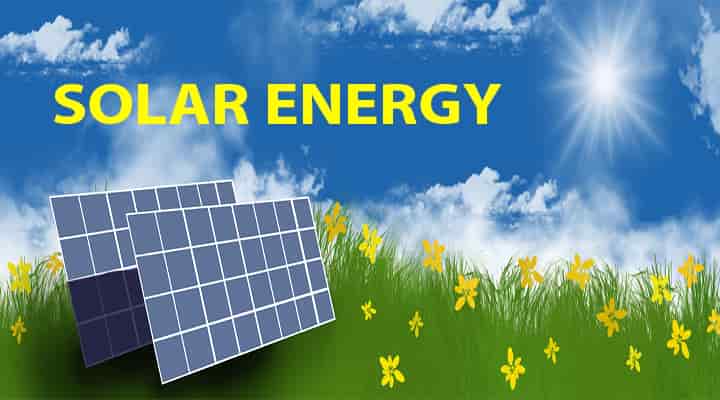
Let’s, explore the details of solar energy!
Sun Power or Solar Power & Solar Energy
The sun undergoes some fusion process and produces huge energy. A small amount of that energy is reached to the earth. A huge energy is released by the sun. This energy is in the form of light and radiation. Sun power or Solar power is simply the conversion of energy when sunlight converts into electricity.
When it comes to the earth, some portions are lost due to reflection, absorption, etc. Approximately,
- A lot of energy received from the sun is reflected and absorbed in atms, clouds & earth’s surface,
- Energy received by the earth from the sun is approximately 51%, the same is shown in the diagram,
However, this energy seems less i.e., 51%, but it is huge in comparison with the world’s requirements.
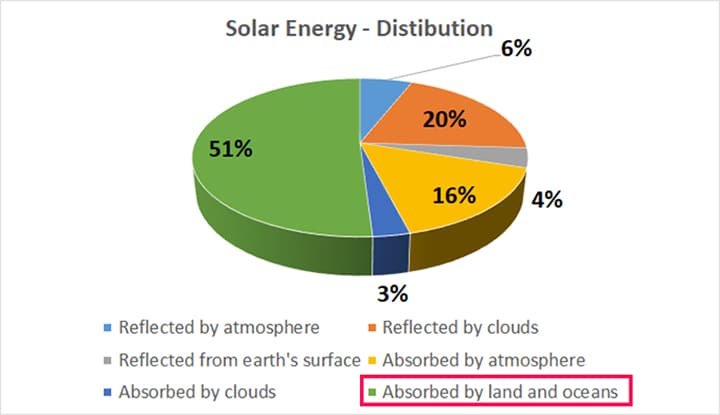
Refer to the above image, how the radiation or absorption happens in the earth. This solar radiation can be converted into thermal energy or electricity to use as clean energy in our daily requirements.
Definition of Solar Energy & Types
Solar energy definition
Solar energy is the most abundant energy resource on Earth. The energy which we received from the sun is called solar energy. This is one of the best renewable energy sources on earth.
- Solar energy comes from the ultimate energy source, the sun.
- Solar energy is very important to provide a clean energy future.
- There are various ways to capture and use solar energy.
- Using solar panels, solar energy is produced in various industries.
History of solar energy
Solar energy is different types:
- Passive Energy
- Active Energy
- Photovoltaic Energy
- Solar Thermal Energy
- Concentrated Solar Power
Passive Solar Energy
In this method, we use solar power without any device. Like daylight, passive solar heating & cooling, etc.
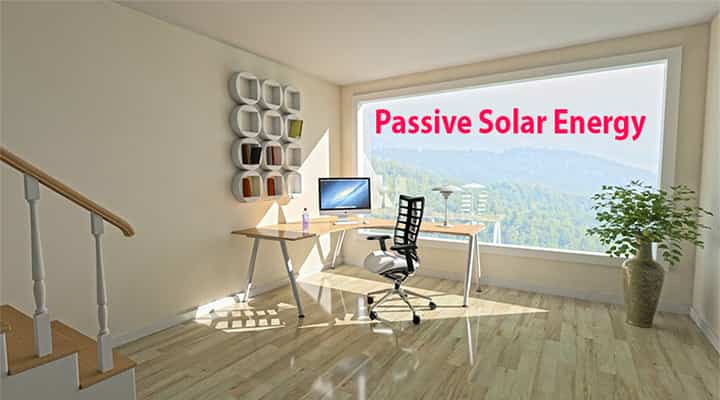
Active Solar Energy
In this method, mechanical or electrical equipment is used to increase system efficiency. Like,
- Active solar space heating, or
- Active solar water heating, etc.
Solar Thermal Energy
This is the heat energy that is produced from solar power using solar heating panels. In the current environmental pollution problem across the globe, the demand for solar thermal energy is increasing day by day. Like,
- Solar space heating,
- Water heating,
- Pool heating, etc.
Photovoltaic Solar Energy
Photovoltaic energy is produced from the incident solar energy by using photovoltaic solar cells. Examples:
- Photovoltaic solar lighting,
- Electricity,
- Cooling, etc.
Concentrated Solar Power CSP
Concentrated solar power is produced from the mirrors or reflectors mainly for large scale power productions. Example: Solar power plants. Are you thinking about buying Solar Products ?
?
What is Solar Panel? Parts and Materials
Solar panels are the main device to produce solar energy. This device or panel converts sun rays into electricity. There are many solar companies across the world and lets try to get a glimpse:
- The solar panel is a collection of photovoltaic cells
- Solar cells are formed grid-like matrix within a metal frame
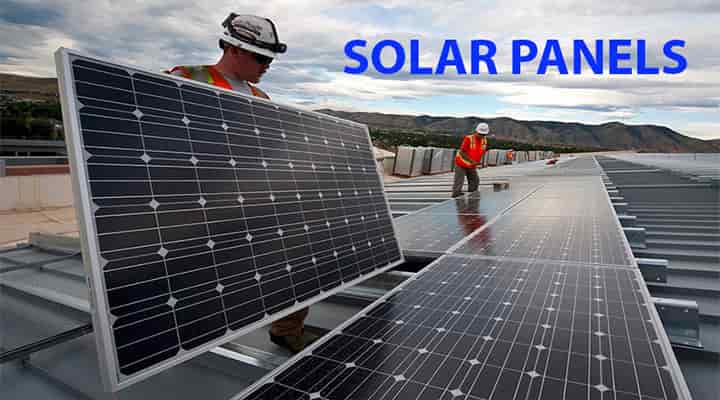
What are the parts of a solar panel?
There are a few parts of a solar panel. Normally a standard solar panel has six components, these are namely, as follows:
- Main Solar cells, normally silicon made
- Metal frame, (aluminum is widely used)
- Casing, (glass is widely used)
- Encapsulant is a material which provides adhesion for the solar cells
- Protective back sheet
- Wirings etc.
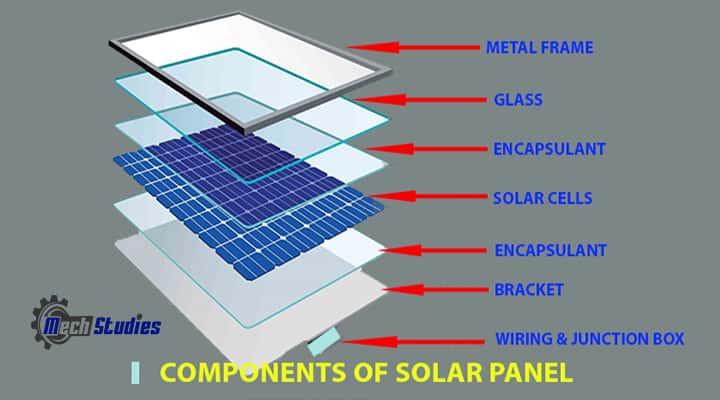
How Solar Panels are made?
There are mainly three kinds of solar panels, generally used.
- monocrystalline solar panels
- polycrystalline solar panels
- thin-film solar panels
Normally, solar panels are made in the following steps:
Step#1: Silicon is produced from sand in an arc furnace.
Step#2: Silicon is collected as solid
Step#3: Melt the silicon rock and make cylindrical shape or ingots
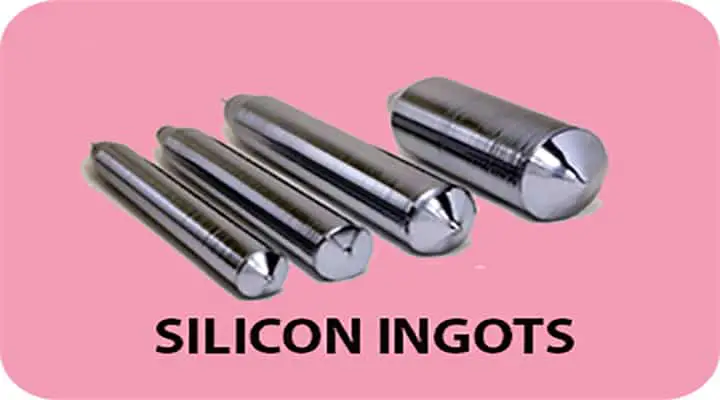
Step#4: Crystal growing
Step#5: Silicon ingot is sliced into thin films. This thin slice is called as wafers. Pure silicon is very shiny and it reflects the sunlight.
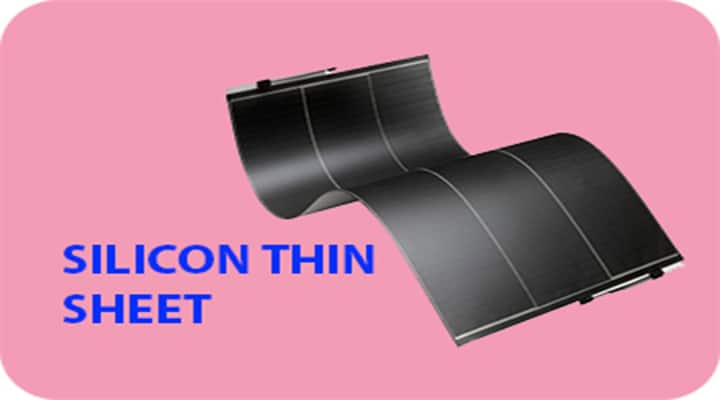
Step#6: Anti-reflective coating is used for silicon wafer to reduce the sunlight losses.
Step#7 – Making Solar cells: Wafers are well treated. Once treatment is done, metal conductors are added on each surface and made a grid-like matrix on the surface. This matrix is nothing but solar cell and it converts solar energy into electricity.
Step#8 – Solar Panel: All solar cells are bonded together by metal connectors and create a link between cells. This structure forms a solar panel.
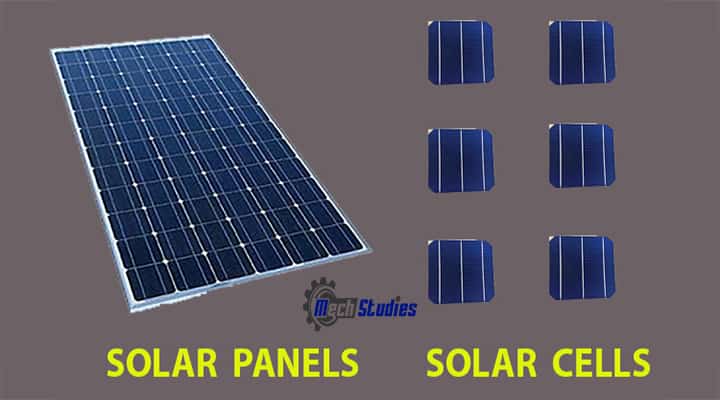
When the solar panel is ready, it is tested to check the performance of solar cells, and certify for ready to use.
How Do Solar Panels Work?
Energy from the sun is renewable or usable energy received from the sun in the form of electric or thermal energy. Now a day, the use of solar power is very common for;
- Heating indoor spaces
- Heating fluids
- Residential applications
- Commercial applications
- Industrial applications
- HVAC system
There are various ways to capture solar energy and convert it into usable energy. There are a few ways to harness solar power:
- Photovoltaic solar power,
- Solar thermal power,
- Concentrating solar power.
- Flat Plate Collector
- Solar Ponds
Photovoltaic solar energy
Description: Photovoltaic is a very common way of converting solar energy into usable electricity. This electricity can be used immediately based on requirements. Else, it can also be sent to the electric grids or stored in a solar battery as well. Solar energy captured in solar panels or solar modules. This solar panel consists of:
- Semiconductors (Silicon cells),
- Metal frame,
- Glass casing,
- Wirings,
How Does Photovoltaic Cell Works? Silicon is a widely used non-metal and it has very good conductive properties. It absorbs the sunlight and converts it into usable electricity. Working principle of photovoltaic cells, step by step:
- Step-1: Light strikes the semiconductor that is silicon cells,
- Step-2: Light rays have photons and these photons hit the solar cell,
- Step-3: Due to the hitting of photons, electrons present in the silicon cell becomes loose from the atoms,
- Step-4: Loose means, these electrons get motion
- Step-5: The motion of electron means, electricity generates,
- Step-6: Conductors are attached to the positive and negative sides of a cell, & form an electrical circuit.
- Step-7: Electric wiring is attached to the positive and negative sides to capture the electricity.
Solar panels are produced by multiple cells and multiple solar panels are wired to fulfil higher demands. This entire process complete with light hits the silicon cell, losing electrons from the silicon cells, and providing motion on it. This is known as the “photovoltaic effect,”. Now, the generated current is known as direct current (DC) electricity and it is necessary to convert it into alternating current (AC) electricity for most household electric appliances.
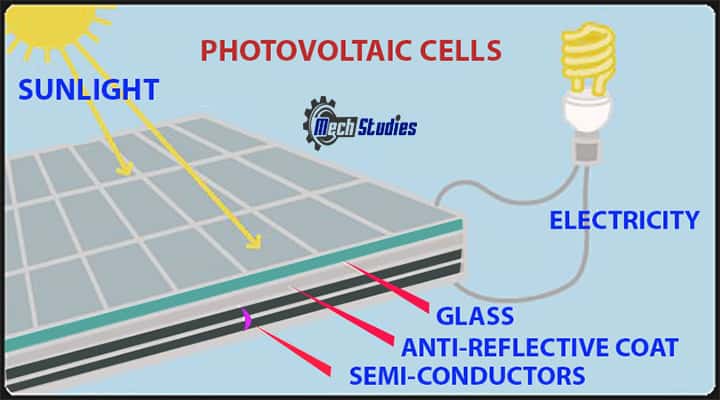
Solar Thermal Energy
Solar thermal means directly capture solar radiation and use many ways.
- This method has a broader range of use
- Effective for large scale application
- Small scale application to generate electricity is not practical.
Solar thermal energy, normally three kinds:
Low-temperature solar thermal energy uses to heat and cool the air to control the temperature. For example: In passive solar building design, the sun rays directly heat the space in the building. If heating is not required, simply block the light.
Mid-temperature solar thermal energy systems for heating water etc. For Example: Here, heat from the sun is captured by collectors on your rooftop and then transferred to the water running through your home’s piping. It has replaced all traditional water heaters.
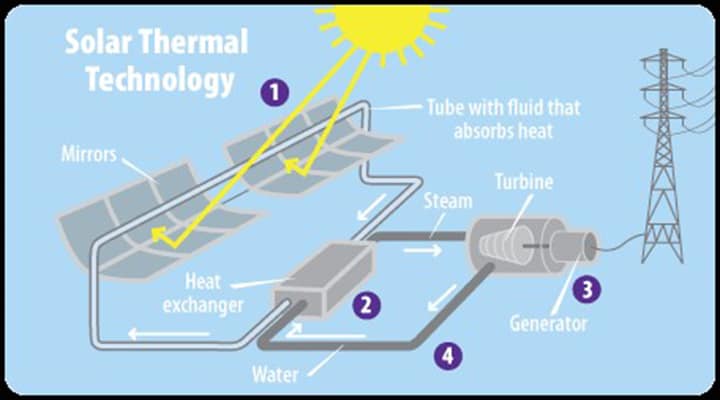
High-temperature, Large scale electricity generation, high-temperature solar thermal energy systems are widely used. This type of technology is known as CSP or concentrated solar power. Let’s try to understand CSP.
Concentrated Solar Power (CSP)
Concentrated solar power or CSP plants employ concentrating or focusing, collectors or reflectors or mirrors to concentrate sunlight. This sunlight received in a wide surface area.
The working principle of concentrated solar power, as follows:
- Mirrors or reflectors may be fixed in place or movable,
- Sunlight falls on the mirrors,
- Mirrors help to concentrate the sunlight,
- A carrier fluid is used, normally water,
- Concentrated sun rays heat the water,
- This heated water is boiled in the boiler,
- Steam is created in the boiler,
- Once the steam is formed, it is circulated to the steam turbine,
- Due to steam pressure, the turbine rotates,
- The generator is connected with the turbine,
- Finally, the generator produces electricity,
- Due to water, heat can be stored even after sunset. This is the main advantage over photovoltaic power.
There are so many CSP in the world .
.
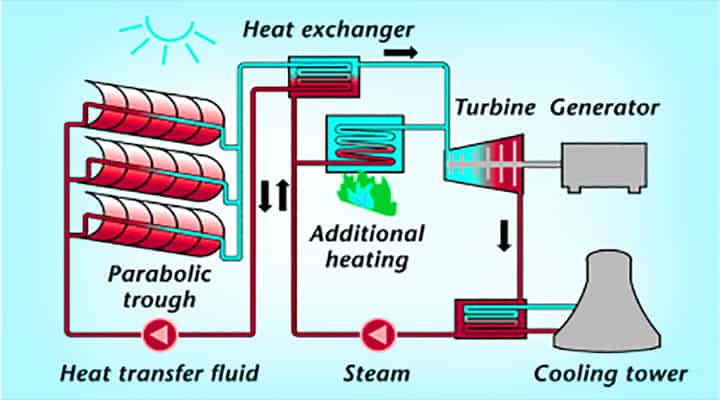
Flat Plate Collector
The flat-plate collectors are widely used panels to capture solar power and convert it to thermal energy. These are mainly used for solar heating applications. Flat-plate collectors consist of glass sheets and blackened metal plate,
- The sunlight falls on the collector and gets heated.
- There are fluid, it may be air or water and it is called as working fluid.
- This carrier fluid flow past the back of the plate.
- The heat can be used directly, as required.
- It can also be transferred to another medium if it is required to store.
- Solar heating applications, or house applications,
- Flat plate collector is helpful to store the energy during a cloudy day or at night time,
- The efficiency of flat plate collectors is 30-80% based on the design,
Refer the below image for a typical flat plate collector,
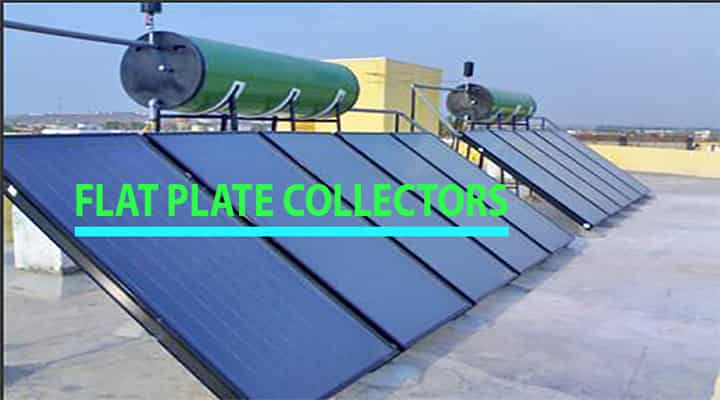
Diagram of typical solar ponds are as follows,
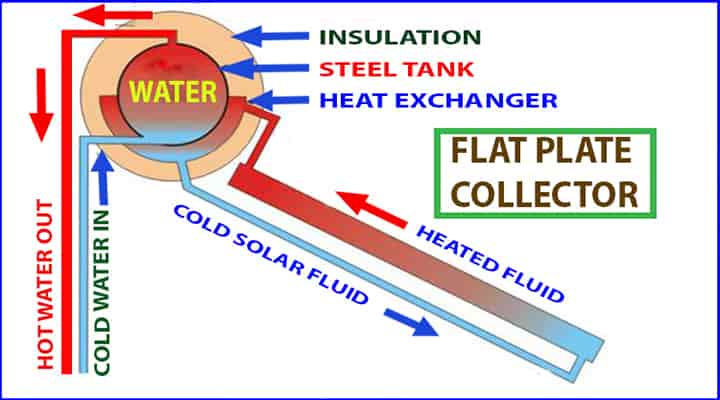
Solar Ponds
It’s a pond filled with salty water to collect solar power. This pond receives solar power through insulation. Later on, this heat is trapped and the water splitting into three layers.
- Uppermost layer: fresh air with low salinity since salt settled at the bottom.
- Middle layer: Insulating layer, salinity is more than the top layer.
- Bottom layer: Lowest layer and where solar power is stored and extraction is possible.
Lets see the basic features of solar ponds:
- Solar Pond gathers heat and expands, density reduces.
- Due to reduced density, rise at the top level and losses heat to the atmosphere
- Coldwater with higher density changes places to warm water and flow happen.
- Natural flow is produced which disperse heat energy.
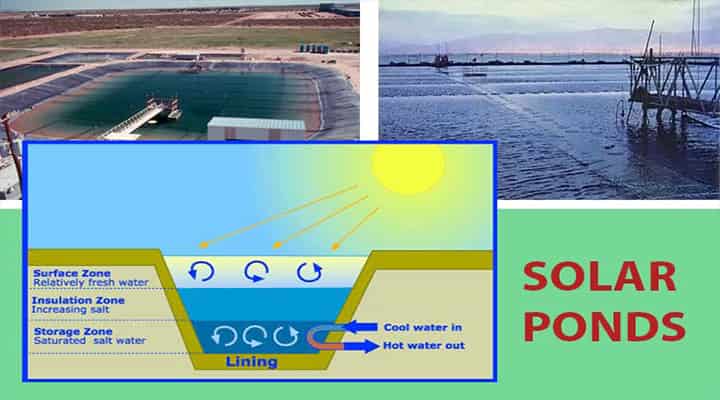
Importance of Solar Ponds
- Salt production
- Aquaculture
Solar Inverter & Electricity
Solar panels produce a direct current or DC electricity. We use AC current in our home appliances. Hence, it is necessary to convert this DC to AC. The solar inverter is mainly used to convert DC current into AC. Normally, three kinds of solar inverters are used,
String inverters
Here, solar panels are connected by “strings”, and that is why it is known as string inverters. Multiple strings of panels can be connected to a single inverter. Power output at the string level is only optimized at string inverters, without the individual panel level.
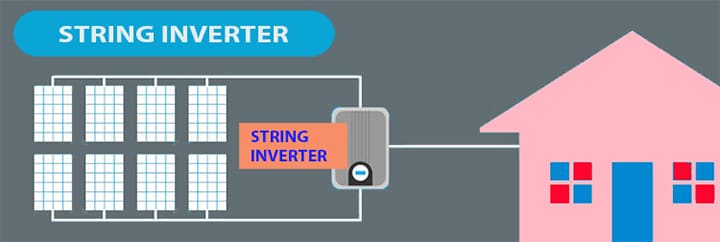
Microinverters
Microinverters are installed on each individual panel, No separate central inverter is required. These are normally mounted onto the back of the solar panel. The power production of each individual panel can be easily monitored by micro inverters.
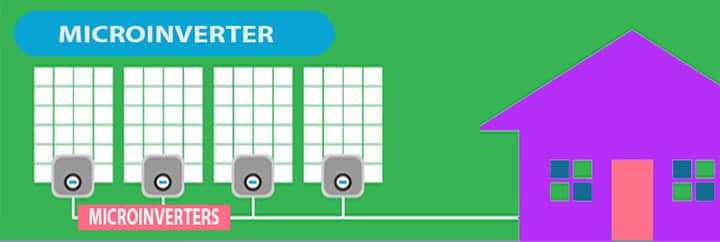
Power optimizer systems
These are located at each panel. It doesn’t convert DC to AC at the panel site, it conditions the DC and sends it to a string inverter. The power production of each individual panel can be easily monitored by power optimizer systems.
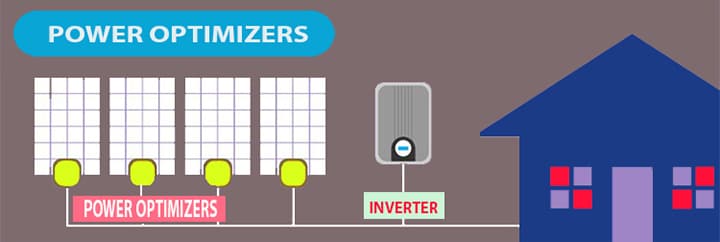
Advantages of Solar Energy
Summary of the benefits of Solar power,
- This is renewable and there is no end
- It is inexhaustible
- It is sustainable
- This energy is clean energy, non-polluting, and specially CO₂–free
- It doesn’t create any global warming
- It will not harm the environment, so, there will not be any acid rain, no smog, or ozone depletion, etc.,
- No fuel-burning is required, hence, no pollution
- Solar water heating
- Space heating
- Solar lighting in various places
- Solar power used in air conditioning
- Solar ventilation system
- Vehicles
- Maintenance is very low
- Portable device applications
- It can reduce energy imports
- Due to less fossil fuel consumption, it generates local wealth
- Solar power helps to generate large-scale electricity generation
- Solar power is very useful for areas which are isolated from the mainland,
- Space heating
- Operating cost is very low
- It doesn’t have any variable costs.
Solar Energy Disadvantages
- The initial cost is very high
- Weather Dependent, in case of the cloudy environment, the efficiency is reduced,
- Solar Energy Storage is Expensive
- Installation of solar panels required a lot of space
- Associated with Pollution due to the installation of panels,
Solar Power Plant Capacity
In 2019, the total solar power installed in the world is 6,27,000 MW. India has installed a total of 42,800 MW solar power. It is comparatively less with respect to the thermal power plant of nuclear power plants, however, the world is now a day looking for renewable energy like solar.
Standards for Solar Power
There are few important standards used in the solar industries,
- ISO 9050; Glass in the building
- ISO 10217: Solar Energy -Water Heating
Solar Panels Manufacturers
In recent time, there are so many organizations are making solar panels due to continuous demands. A few of them are listed below,
- LG Solar.
- Panasonic.
- SunPower.
- Thermax
- Jinko Solar.
- Hanwha Q Cells and many more.
Conclusion
Hence, we have got a basic idea about solar power, solar energy as well as solar panels. Any questions, please write in the comment box.
